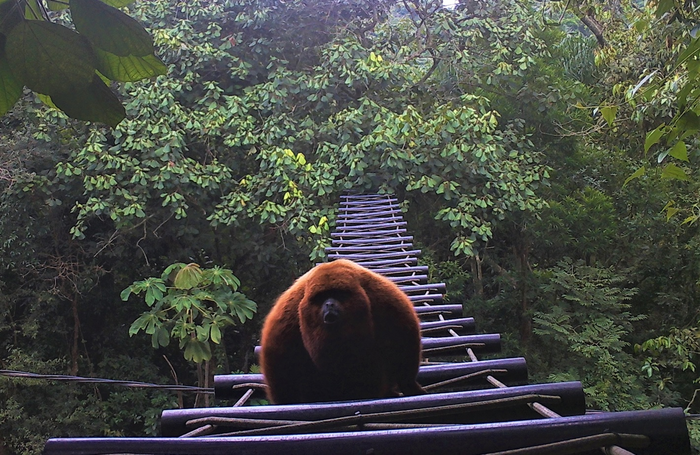Canopy bridges connect forests, wildlife, and international researchers
Republished from Mongabay on 11th July, 2023
The expansion of roads and highways has negatively impacted arboreal animals by separating them from essential resources such as food, shelter and mates.
Canopy bridges provide a simple solution to this problem by allowing animals to cross over roads safely and maintain gene flow between populations.
A recent special issue of the journal Folia Primatologica includes 23 peer-reviewed case studies on canopy bridge research from 14 countries, highlighting the growing interest in this topic.
Canopy bridges can be low cost, but design and implementation can be challenging, so conservationists and practitioners must continue to work together to find efficient solutions that work for animals.
Roads and highways wind through forests worldwide, forming an expanding network that connects humans but can hurt animals. Animals are hesitant to cross roads, and for those that move only through the treetops, such as arboreal mammals, a road can represent an impassible barrier.
“For arboreal animals, the barrier effect is profound. They will not cross on the ground. So that means we’re slicing and dicing their habitat into tinier and tinier pieces,” Tremaine Gregory, an ecologist at the Smithsonian’s National Zoo and Conservation Biology Institute, told Mongabay. “They’re isolated from the resources that could be on the other side of the road. Everything from food and shelter to mates.”
Fortunately, in many locations, a simple solution exists: the canopy bridge. A vine or connecting tree branches form a natural canopy bridge, but a single rope or ladder-like structure built by humans can fill in these gaps as well and allow animals to cross over the road.
A black howler monkey crossing a lattice bridge in Paraíba, Brazil. Photo by Gerson Buss
“Artificial bridges, which are becoming of increasing interest to everyone from researchers to high school groups, can be very low cost,” Gregory said. “They allow animals to cross from one side to the other, and each crossing is a major opportunity for maintaining gene flow and the survival of populations.”
A recent special issue of the journal Folia Primatologica, brings together 23 peer-reviewed case studies on canopy bridge research from 14 countries. This is a huge increase in the published literature on the topic, as only 32 studies had been previously published.
The special issue was born out of a virtual symposium in 2021 organized by Gregory and Fernanda Abra, a postdoctoral fellow at the Smithsonian’s National Zoo and Conservation Biology Institute, that brought canopy bridge researchers and practitioners together to discuss solutions.
“This special issue features new insights from researchers and practitioners from all around the globe that can guide important changes toward arboreal species conservation,” Abra, the co-editor of the special issue and co-author of two of the publications in it, said in a statement.
Research topics from the special issue include rope bridges for wildlife in Singapore; electrical wires as bridges for the dusky langur (Trachypithecus obscurus) in Thailand; mammal use of canopy bridges over a highway in Mexico; a community building a canopy bridge for black howler monkeys (Alouatta caraya) in northern Argentina; connecting forest fragments containing endangered species in northeastern Brazil; canopy bridges in a forest in northeastern Bangladesh; the effects of road construction on arboreal mammals in Japan; and many more.
Female howler monkey (Alouatta palliata palliata) uses a canopy bridge in Playa Hermosa, Costa Rica which is designed to support prehensile tail use. Photo by Ines Azofeifa
One study was the first to report orangutans using an artificial canopy bridge. The researchers found that the fuzzy orange primates are adaptable, preferring to use the safer canopy bridge than to risk the road. They also preferred simpler bridges.
“Primates [didn’t] prefer a luxury canopy bridge,” study lead author Didik Prasetyo, a biology professor at National University in Jakarta, told Mongabay. “We propose that the landowner not build a complex canopy bridge which [would be] high cost and less effective for primate[s].” However, animals that use these bridges can be a much easier target for hunters and poachers, so they will need to work with landowners to be sure these bridges are kept secure.
Although canopy bridges are easy to understand, there is a lot to navigate in the canopy, Gregory said. For instance, do you tie the canopy bridge to a tree? Do you tie it to concrete posts? Do you put up a steel post? Is the smell of the material going to deter animals? How does it withstand UV rays? How does it withstand freezing and wind?
Gregory said she hopes the research, community and connections formed during and since the symposium will continue to improve everyone’s work. “We have a lot to learn from each other.”
She added, “Designing and implementing bridges animals will use can be extremely challenging. As the global road system explodes, it is perfect timing for conservationists and practitioners to learn from each other to more efficiently implement solutions that work.”
References:
Canopy bridges for conservation: Case studies from around the world. (2022). Folia Primatologica, 93(3-6). Retrieved from: https://brill.com/view/journals/ijfp/93/3-6/ijfp.93.issue-3-6.xml
Prasetyo, D., Lestari, D. A., Wahyuni, T., & Ismanto, A. D. (2022). The effectiveness of artificial canopy bridges for the diurnal primates within a hydroelectric project in North Sumatra-Indonesia. Folia Primatologica, 93(3-6), 271-285. doi:10.1163/14219980-20211106.
This article has been republished from Mongabay. View original article
Author: Liz Kimbrough, staff writer for Mongabay



